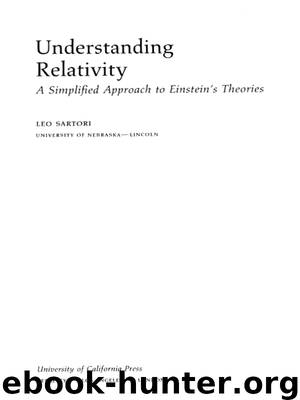Understanding Relativity by Leo Sartori

Author:Leo Sartori
Language: eng
Format: epub
Publisher: University of California Press
6.4. OTHER LENGTH PARADOXES
In this section we analyze briefly two other paradoxes based on the contraction effect. Each one presents some points of interest.
Paradox of the Fast Walker8
A man walks very fast over a rectangular grid, of the type used in some bridge roadways. The rest length of the walker's foot is equal to the spacing between grid elements. In the rest frame of the grid, his Lorentz contraction makes him narrower than the grid spacing; observers in that frame expect him to fall in. In the rest frame of the walker, in contrast, the grid spacing is contracted and he should pass over the grid without any difficulty. The two predictions are contradictory.
Although this paradox bears some similarity to that of the pole and barn, the two differ in one important respect. In the pole and barn problem, we concluded, the analyses in both frames are correct and there is in fact no paradox. Such a conclusion is not acceptable in the present problem. The two predictions are definitely incompatible: the question of whether or not the walker falls into the gridwork is subject to direct observation and must have an unambiguous answer. Either he falls in or he does not. If special relativity is self-consistent, one of the analyses must be wrong. Which is the right one, and why?
For ease of discussion we replace the walker with a rectangular block that moves along a tabletop containing a rectangular hole. Both the block and the hole have proper length L. V is the velocity of the block in frame S, the rest frame of the table, and γ is the corresponding Lorentz factor. Figure 6.15 shows the story as it appears in frame S, where the block's length is only L/γ.
One additional modification simplifies the analysis without altering the essential features of the paradox. In the problem as originally stated, the block would topple over the edge of the hole and would then rotate as it falls, in a rather complicated motion. To avoid this complication, we assume that the block is suspended from vertical threads that move along at the same speed as the block (sketches [a] and [b]). As soon as the block is entirely over the hole (sketch [c]), all the threads are cut simultaneously (in frame S) and the block begins to fall, remaining horizontal as it does so. E1 and E2 denote the events at which the threads that support the two ends of the block, Q and P, are cut.
Sketch (d) shows the block falling, and entirely within the hole. A short while later the forward end of the block, Q, collides with the far side of the hole (event E3, sketch [e]).
The resolution of the paradox becomes apparent when we translate the pictures of Figure 6.15 to frame S', in which the block was originally at rest and the (narrow) hole moves from right to left at speed V (Fig. 6.16). Once again simultaneity plays a critical role.
The key to the argument is that in S', the threads are not all cut simultaneously.
Download
This site does not store any files on its server. We only index and link to content provided by other sites. Please contact the content providers to delete copyright contents if any and email us, we'll remove relevant links or contents immediately.
The Complete Stick Figure Physics Tutorials by Allen Sarah(7310)
Secrets of Antigravity Propulsion: Tesla, UFOs, and Classified Aerospace Technology by Ph.D. Paul A. Laviolette(5311)
Thing Explainer by Randall Munroe(3877)
The River of Consciousness by Oliver Sacks(3543)
The Order of Time by Carlo Rovelli(3145)
How To by Randall Munroe(3038)
A Brief History of Time by Stephen Hawking(2962)
I Live in the Future & Here's How It Works by Nick Bilton(2938)
The Great Unknown by Marcus du Sautoy(2649)
What If?: Serious Scientific Answers to Absurd Hypothetical Questions by Randall Munroe(2637)
Midnight in Chernobyl by Adam Higginbotham(2485)
Blockchain: Ultimate Step By Step Guide To Understanding Blockchain Technology, Bitcoin Creation, and the future of Money (Novice to Expert) by Keizer Söze(2450)
Networks: An Introduction by Newman Mark(2360)
The Meaning of it All by Richard Feynman(2300)
Easy Electronics by Charles Platt(2282)
The Tao of Physics by Fritjof Capra(2231)
Midnight in Chernobyl: The Untold Story of the World's Greatest Nuclear Disaster by Adam Higginbotham(2179)
When by Daniel H Pink(2084)
Introducing Relativity by Bruce Bassett(2080)
